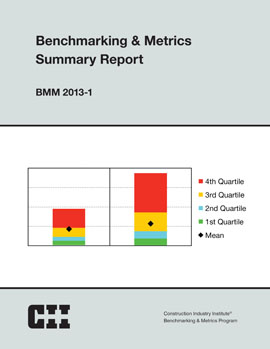
Benchmarking & Metrics Summary Report
The Construction Industry Institute (CII) established the CII Benchmarking and Metrics (BM&M) program in 1995 to provide self-analysis tools to member companies, quantify the benefits of CII Best Practices, and support research teams. When the last benchmarking summary report was published in 2002, the program had achieved those goals by deploying the first online benchmarking questionnaire and by generating key reports and many industry-sponsored studies. The program has continued to evolve over the last decade to meet the needs of CII members and to support the Institute’s strategic goals.
The Benchmarking & Metrics (BM&M) Committee guides the program, interfacing with CII leadership through the Board of Advisors and other committees to serve the membership better. The BM&M committee oversees the program and works alongside the CII benchmarking staff to promote and develop benchmarking initiatives. As the needs of the membership have changed, so have the services provided by the BM&M program. And, as the membership evolves in the future, the program will stay attuned to its emerging needs.
BM&M Committee members composed this summary report to provide insight into the current status of the program and the services it provides, with emphasis on the changes that have taken place since 2002. CII members that have not been involved with the program for several years are strongly encouraged to revisit the program to learn how it has changed and how it may now benefit their respective organizations. Given past and recent work CII has done to improve the program, participating companies will gain tremendous value in both the near and long terms.
The program has responded to industry-specific benchmarking needs with absolute metrics and data to support member companies engaged in the pharmaceuticals and biotechnology, upstream oil and gas, downstream oil and gas, and healthcare sectors. The set of metrics has been broadened, the database has grown, and the toolset available for interface with the data has been improved significantly. Program expansion will continue in industry sectors that have a need and are willing to participate and provide support. Productivity benchmarking for both engineering and construction have also been developed.
The CII strategic goal of expanding its geographical reach to serve members’ global operations is supported by the benchmarking program through the establishment of Performance Assessment Labs (PALs) in regions throughout the world. This expansion allows the program to leverage local support, knowledge, and resources, while expanding and improving the program’s capacity to serve member companies. PALs currently operate in Brazil and Canada, and CII plans to develop more PALs as opportunities arise.
The traditional research objectives of CII continue to find support from the benchmarking program. Many new research teams use data and definitions from the program that help form their data collection and research analysis framework. The BM&M program also continues to produce the annual safety report, which has become an industry-standard reference for CII members and non-members alike.
Finally, the BM&M program enables members to perform self-analysis of project performance and best practices use. The database can also be mined to formulate typical industry norms that can help users understand how the industry in general performs. The newly released Performance Assessment System (PAS) interface provides a more intuitive and user-friendly approach to conducting self-analysis and mining the data to support decision making. This summary report also provides several examples of representative industry data analysis and how it may be used in practical applications.
The BM&M Committee guides the program, interfacing with CII leadership through the Board of Advisors and other committees to better serve the membership. The BM&M Committee oversees the program and works alongside the CII benchmarking staff to promote and develop benchmarking initiatives. As the needs of the membership have changed, so have the services provided by the BM&M program. And, as the membership evolves in the future, the program will stay attuned to its emerging needs (BMM2013-1, p. 2).
The traditional research objectives of CII continues to find support from the benchmarking program. Many new research teams use data and definitions from the program that help form their data collection and research analysis framework. (BMM2013-1, p. 15)
The BM&M program also continues to produce the annual safety report, which has become an industry-standard reference for CII members and non-members alike. The BM&M system assessed the level of implementation of safe practices in 2001 for feedback and to quantify practice impacts on project performance. Figure 13, provided for illustration, shows safety practice use norms for owner domestic projects segregated by cost category. Project size has a significant impact on the level of practice use as depicted in the figure. Larger projects report greater practice use on average. This finding prompted research into small projects to determine how practices may need to be modified for use on these projects. Note: BM&M programs for Safety are included in the Safety Knowledge Area. (BMM2013-1, p. 6)


